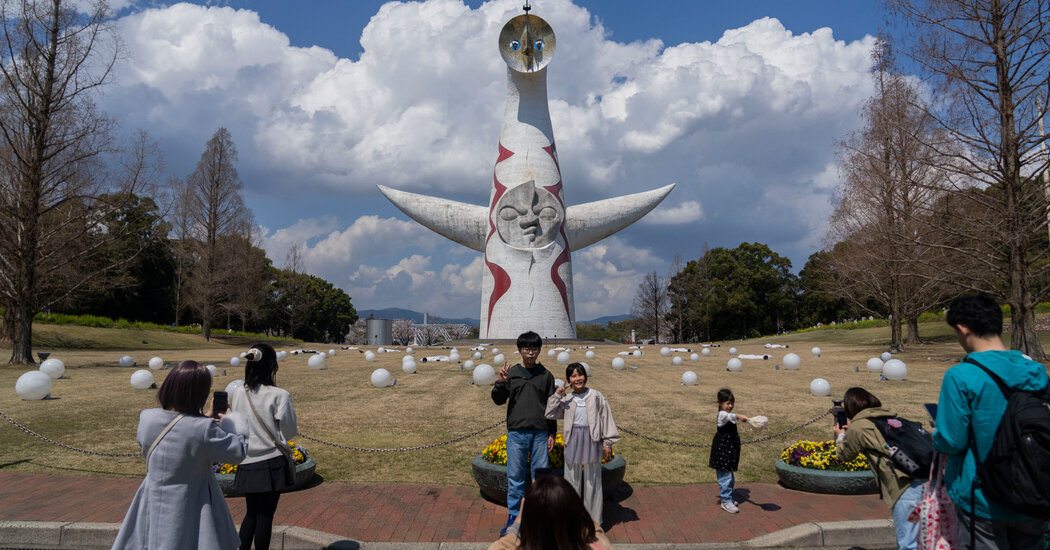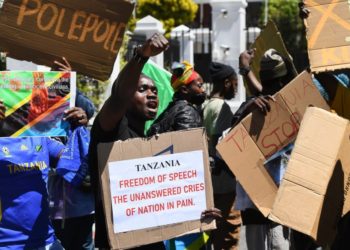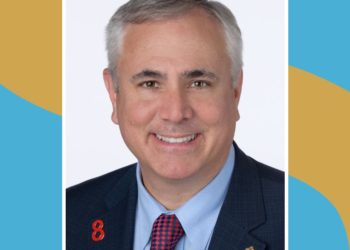When Osaka first hosted the World Expo in 1970, a quarter-century after World War II, Japan’s economy was newly affluent and expanding so rapidly it was hailed as an economic miracle. The Expo broadcast that momentum to the world.
It was the first World Expo — a tradition dating to 1851 where countries gather to show off their cultures and achievements — to be held in Asia. Japan spent lavishly, displaying innovations like moving walkways, prototype cordless phones and a 230-foot sculpture with a gold mask said to be looking toward the future. The Expo drew 64 million visitors — equivalent to over half the population of Japan at the time.
Now, 55 years later, Osaka is hosting the World Expo again. On an artificial island in the city’s bay, architects have erected a mile-long wooden ring encircling dozens of pavilions. But while the current Expo, which opened a week ago, seeks to recapture the fervor of its predecessor, Japan stands in stark contrast to where it was in 1970.
Since the bursting of Japan’s real estate and stock bubbles in the early 1990s, the economy has stagnated. The country’s population is shrinking and rapidly aging. Debt levels have ballooned and prospects for growth are being further imperiled by escalating trade tensions with the United States.
When thinking back to the decades since the 1970 Expo, many visitors to the original event, now in their 60s or older, allude to a feeling of Japan’s economic might having “sunk” in a world increasingly roiled by trade divisions. Some hope the current Expo may prove to be a moment of national reinvention.
In a quiet neighborhood in Osaka, a few rail stops away from the 2025 Osaka Expo site, Takahiro Moritaka, 65, runs a small restaurant serving savory Japanese pancakes that he flips on a griddle behind the counter. He was 10 when his parents took him to the 1970 Expo.
“The atmosphere was very different then,” Mr. Moritaka said. “In the 1970s, it was a feeling of many things being on the rise and moving forward rapidly.”
The 1970 Expo was, for Mr. Moritaka and many in his generation, one of their first experiences with the other cultures showcased by the event’s pavilions and exhibits. It was at the Expo that Mr. Moritaka and others saw foreigners for the first time and tasted foods like Kentucky Fried Chicken.
It was also around this time that many in the West were becoming aware of modern Japan and the tremendous strides its economy had made since its military defeat in World War II. Steel, electronics, and automobile pavilions showed off futuristic iterations of products Japan was increasingly exporting overseas.
The aim of Expos at the time, including one held previously in New York in 1939, was for “great powers” to “showcase how they viewed the world and the technologies that they achieved,” said Kenji Yoshida, a senior adviser for the 2025 Expo.
Now, he said, “55 years have passed, and Japan and its relationship with the world have changed.”
During the lead-up to this year’s Expo, the national excitement that surrounded the 1970 event has been noticeably absent. That’s despite Expo advertisements scattered throughout Japan’s train stations and a late-blooming national love for the event’s mascot, a red and blue, globular ring-shaped creature named Myaku-Myaku.
The Expo organizers have said they want to attract more than 28 million visitors over the six months the event will continue. But ticket sales have lagged well behind that target. The Expo has also been criticized as a waste of taxpayer money, with costs surging about $1 billion above original projections.
More recently, an even darker shadow was cast over the event by President Trump, who, a few days before the Expo’s open, announced double-digit percentage tariffs on many of the countries participating in the gathering. That included a 24 percent tariff on Japanese goods that Japan’s prime minister called a “national crisis.”
Hiroki Ogasawara, a professor of intercultural studies at Kobe University, said that escalating trade hostilities would probably continue to dominate global attention in the coming months and color the way the Expo is remembered. “What is the world currently focused on? Trump’s tariffs,” he said.
With regard to the Expo, Mr. Ogasawara said, “It may only be Japan that is paying attention.”
Early on Monday, the day after the Expo’s opening, Eiko Nakanishi, 49, and her father, Masao Nakanishi, 77, made a beeline to the American pavilion. Inside the wedge-shaped buildings, a red, white and blue digital star danced across screens depicting past space missions while a voice sang about the virtues of the world working together.
Ms. Nakanishi said her father had wanted to go to the American pavilion to see a moon rock collected during the Apollo space mission in 1972 — much like the moon rock he saw displayed at the 1970 Expo when he was 22.
Ms. Nakanishi said she was impressed by the technologies on display at the Expo. “Japanese society as a whole is sinking, and society is becoming one where it is not easy to feel motivated,” Ms. Nakanishi said. “But coming here makes you think that the future can be bright,” she said.
The previous day, Katsumi Kusada, 81, and his wife Yaeko, 77, traveled with an Expo tour group from Hiroshima, in Japan’s southwest, to Osaka. But rather than attend the opening day ceremonies, they were sitting on a bench across town in a park commemorating the previous 1970 Osaka Expo.
Both of the Kusadas said they remember Japan’s liveliness and excitement during the Expo 55 years ago. Mr. Kusada was a toddler when the United States dropped an atomic bomb on Hiroshima in 1945, and his father died in the blast. For him, the 1970 event “felt like a place where you could have dreams about the future,” he said.
“Today, too, there are wars, and Japan’s population is shrinking and shrinking,” Mr. Kusada said. While he didn’t think the Expo would have implications for either of those realities, he said that he still appreciated the event as a kind of festival.
“I’ve always been fond of festivals,” Mr. Kusada said. “All of Japan enjoys a festival.”
River Akira Davis covers Japan, including its economy and businesses, and is based in Tokyo.
Kiuko Notoya is a Tokyo-based reporter and researcher, covering news and features from Japan.
The post At World Expo, Japan Recalls a Faded Dynamism appeared first on New York Times.




